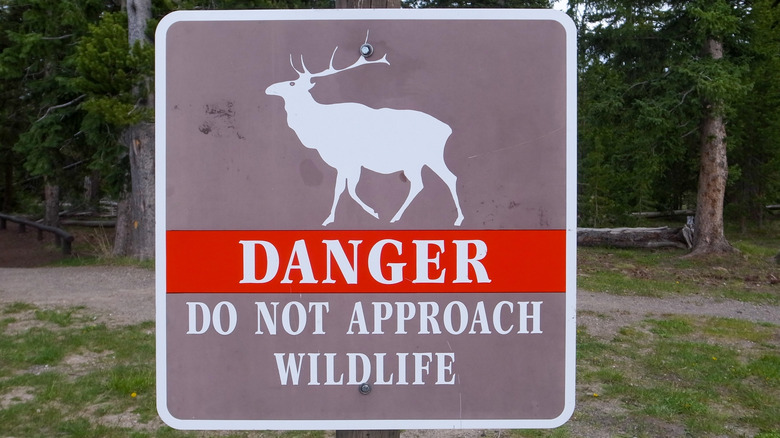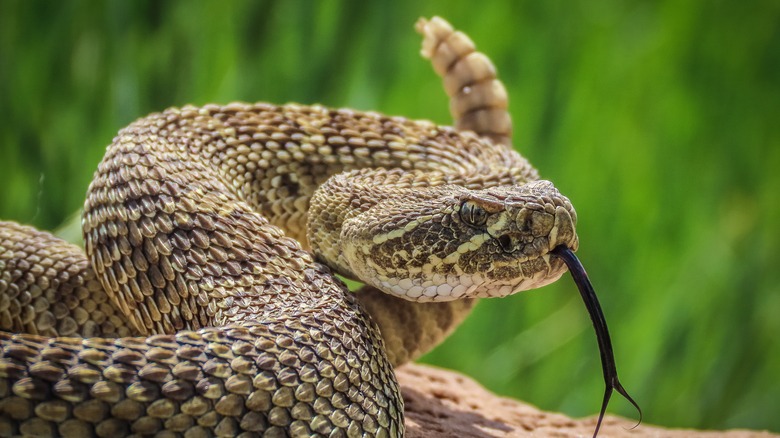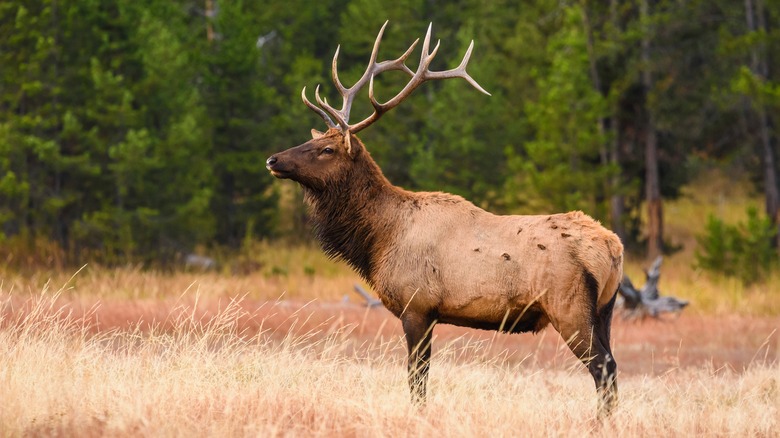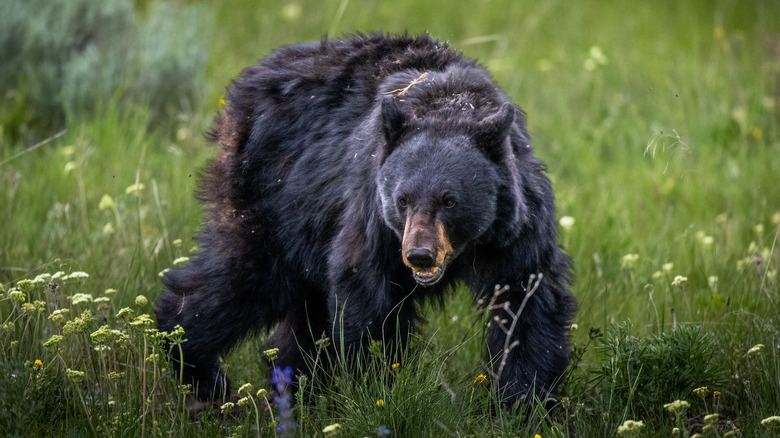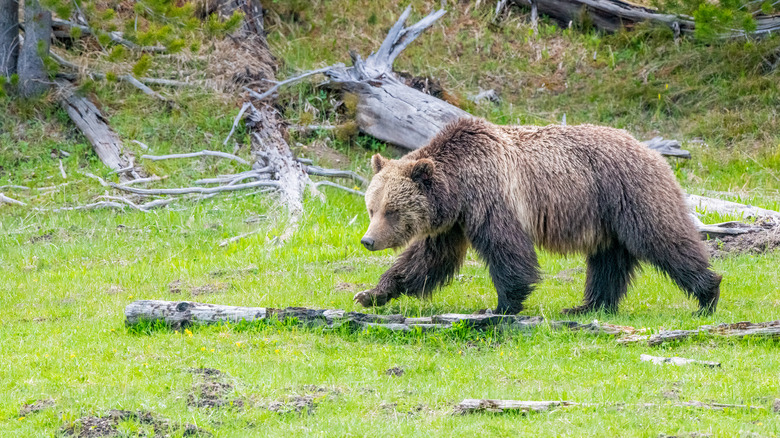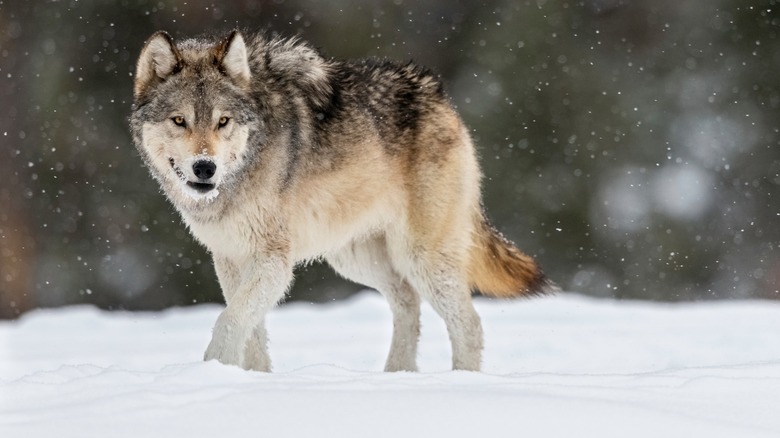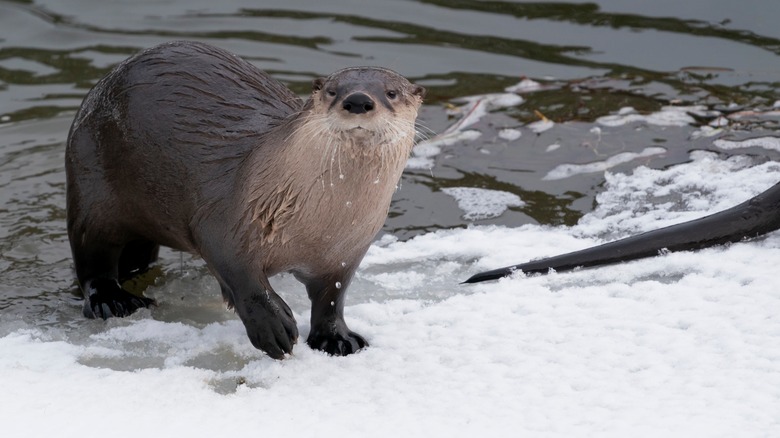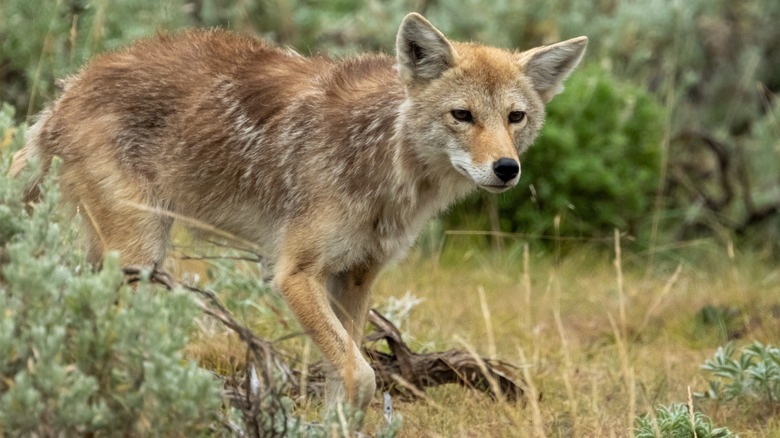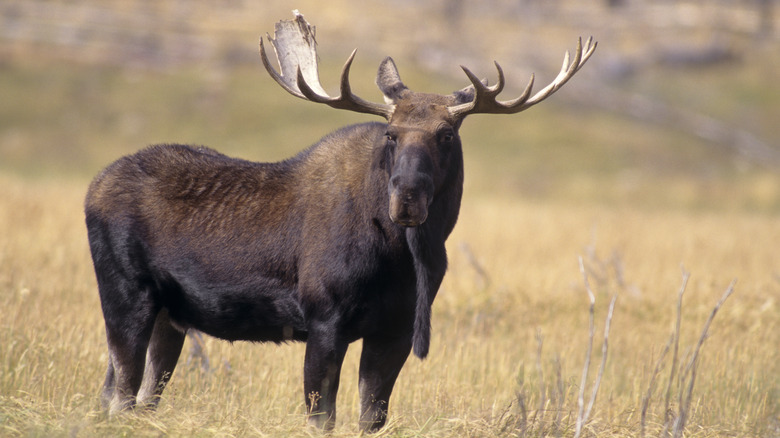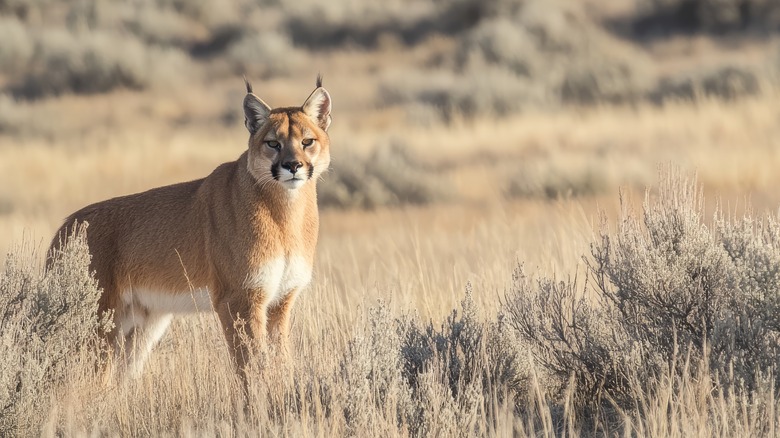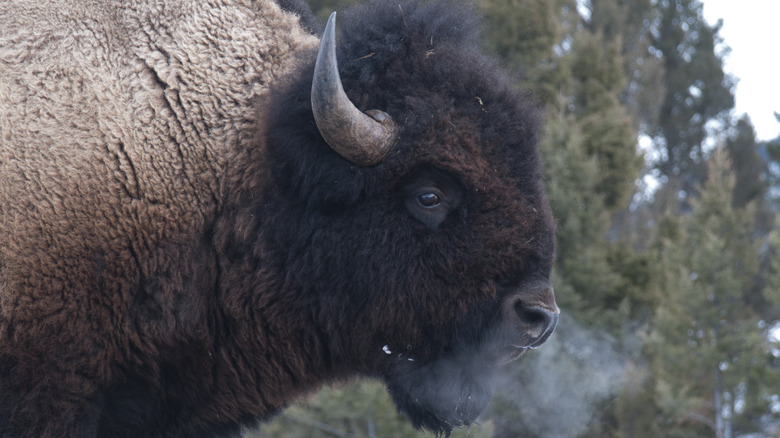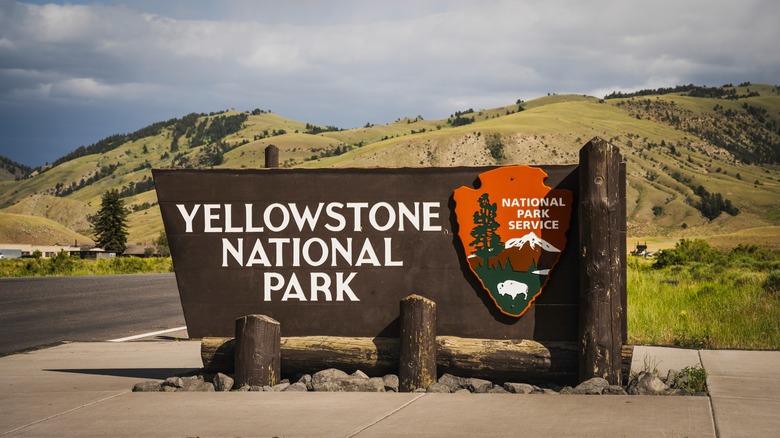10 Dangerous Animals Tourists Should Never Approach At Yellowstone National Park
We may receive a commission on purchases made from links.
Yellowstone ranks as one of the most expansive national parks in the United States. Tourist concentration naturally occurs within developed zones, but these areas only make up a minute portion of the park's territory. With more than 2 million acres and more than 1,000 miles of trails surpassing elevations of 7,000 feet, there's plenty more to explore — and hiking is a wonderful way to see it.
However, hitting the hiking trails exposes you to risk. There is exceptional biodiversity in this protected wilderness, including 67 species of mammals — and they are all wild animals that you must never approach. And it's not just those venturing into the backcountry that need to be aware. Many encounters happen in the frontcountry areas, and studies have shown that most injuries occur when people approach animals to try to snap a selfie with them.
Observing them from your vehicle is the safest play. But wherever you view, National Park Service (NPS) regulations state you need to stay 100 yards (300 feet) away from bears, wolves, and mountain lions, and at least 25 yards (75 feet) from everything else. Many visitors choose to ignore these rules, and there are countless viral videos showing the results. Still, wildlife isn't the cause of the majority of deaths that occur in American national parks. But that's still not a free ticket to get close. So with that in mind, let's take a look at some of the most dangerous animals in Yellowstone Park that you really shouldn't go near.
Prairie rattlesnakes
The prairie rattlesnake, or Crotalus viridis, is Yellowstone's only venomous snake. It can grow to more than 4 feet, and these sun-worshipping serpents reside in the park's warm lower elevations along the Yellowstone River. Nature has equipped this snake with an ominous rattle that leaves you in no doubt about its presence. If you hear it, execute a careful, unhurried retreat in the opposite direction.
Prairie rattlesnakes strike when they feel threatened. However, the good news is that there have only ever been two recorded bites in the entire history of Yellowstone National Park, and the chances of actually dying from its bite are fewer than one in a hundred. However, if you are bitten, seek immediate medical attention because this snake's venom can manifest within minutes, and resist the urge to employ dangerous folk remedies. Don't apply ice, don't use a tourniquet, don't try to suck the venom out, and don't try to cut the wound — none of these will help. Maintain your composure and keep the wound below the heart if possible to slow venom circulation.
Elk
Elk possess explosive speed and can change direction in an instant, leaving potential victims with zero chance of outrunning and little chance of outmaneuvering. There are several situations when you might unwittingly agitate an elk, one being if you get too close to their young. Mother elk are fierce guardians and may launch a protective attack even if their calves are out of sight. The bull elk can also get aggressive, and people have been inflicted with devastating injuries during their tempestuous mating season, otherwise known as the rut. It takes place from late August through early October, the best time to visit to enjoy the vibrant fall colors of Yellowstone NP. This is when you will hear their haunting bugles echoing around the park while they engage in some spectacular sparring and aggressive harem herding.
It is quite the spectacle, but you should never get too close. Maintain that NPS-recommended distance of 25 yards (75 feet). But, during the rut, you may even want to extend that buffer zone, as it is possible for these testosterone-fueled bulls to launch a charge across distances that normally provide adequate protection. And just forget about getting close for a selfie — it's irresponsible. Use a telephoto lens to photograph elk. Don't approach them. If one gets too close to you, back away immediately. If you are charged, get behind a vehicle or any other substantial barrier. If no sanctuary presents itself, get to the nearest one as quickly as you can. Keep in mind that elk can run at speeds of up to 45 mph, so choose your refuge carefully.
Black bears
Despite their size, black bears have surprisingly gentle temperaments. In fact, if you catch them off guard, they're more likely to scramble up a tree rather than attack. This is one of the main differences between them and grizzlies. However, encounters aren't unheard of, especially when food is at stake — and that's why campsites can be a problem. Make sure you store food correctly — almost all bear trouble can be avoided if the smell of food or garbage doesn't attract them. In the summer of 2025, one instance of this in Yellowstone ended with the bear being "removed," which is one way to say park authorities decided to kill it.
So, in this instance, the bear was the victim. In the past, people have been victims. Even so, the numbers aren't anywhere near what you might think. There have only been 61 deaths at the paws of black bears in North America since 1900, according to The Alaska Life, which translates to roughly one every other year. Encounters usually end in scratches and bruises, but this usually only happens when the bear is responding to a perceived threat. In other words, their actions are mostly defensive.
In Yellowstone, the number of fatalities involving black bears is just eight. If you see one performing a bluff charge and making loud noises, it is most likely a show of anxiety as opposed to a predator preparing an aggressive attack. But back away slowly and stay calm if you want to avoid triggering chase instincts. If it doesn't leave or starts edging closer, it might be time to make yourself look bigger. You should also flap your arms, throw a couple of rocks, and yell loudly. If you're apprehensive about bears, carrying bear spray might put your mind at rest.
Grizzlies
The grizzly is a formidable brown bear subspecies that roams the wilderness of North America, including the rugged terrain of Yellowstone National Park. It dwarfs its black bear cousin in both physical stature and willingness to engage in confrontational behavior — but only when circumstances demand. They can attack when surprised, especially at close quarters. This can trigger the bear's most aggressive defensive response. Reactions are instinctive, and those protective tendencies know no bounds when cubs are involved, too. However, attack statistics are still relatively low, with only 44 grizzly-related injuries in Yellowstone since 1979, according to the NPS. But they are still a huge danger, and the NPS recommends you avoid hiking at times when they are most active. That means exploring during the daylight hours only — nighttime is a no-go and dawn and dusk are off-limits, too.
If you encounter a bear in Yellowstone, or anywhere for that matter, running can transform the situation into a predatory pursuit. That's not really the best result, so it makes sense to stand your ground. Bear deterrent sprays represent your most reliable defense, as one visitor found out while hiking the Turbid Lake Trail in September 2025. The 29-year-old man managed to deploy a spray after an accidental encounter, although it didn't stop the bear in time to prevent it from inflicting injuries. The man required a helicopter evacuation after what was the first grizzly attack on a person in the park since 2021. The takeaway? Carry bear spray, but also know how to use it. But when an attack is imminent, your survival may depend on how well you can convince the bear that you pose no threat. Be submissive and drop to the ground on your belly, protect your neck with interlocked fingers, and play dead.
Wolves
Since wolves were reintroduced to Yellowstone more than three decades ago, the Yellowstone Wolf Project has been conducting extensive research and has documented everything from pack dynamics to ecosystem effects. Figures available from the NPS in 2024 showed a thriving population of 108 wolves organized into nine packs with sizes ranging from four to as many as 25. Out of the 41 newborn pups that year, 37 survived. These figures show the commendable success Yellowstone has had since the reintroduction, and visitors to the park must contribute to that success.
These naturally cautious animals like to maintain a distance, and attacks by healthy, wild wolves are almost unheard of. However, there are documented incidents, but these attacks predominantly involve rabid wolves or those that have become habituated. And it is the latter that park visitors must avoid. It's essential that the animal remains wary of humans. If they lose their natural fear, they risk being seen as dangerous, and individual wolves that approach and cause problems are more likely to be "removed" by park staff.
Recently, there has been a rise in individual wolves approaching park visitors and vehicles, which has prompted intervention by park management. You should never provide food sources for wolves, intentional or not. And, with wolf-watching quickly becoming a favorite recreational activity, maintain a respectful distance and never encourage an approach. In fact, Yellowstone has implemented a 'no howling' rule to help prevent piquing the wolves' curiosity.
River otters
The playful river otter can be a surprisingly aggressive creature and definitely one you should avoid approaching. Their preference for areas with minimal human presence means that encounters are rare and most pass without incident. But not always. Historical records reveal 39 attacks worldwide up to 2011, according to the Oceanographic Environmental Research Society, with a further 20 incidents over the subsequent decade, although these numbers include both wild and captive animals. No fatalities have been recorded in the U.S., and some of those post-2011 cases had a root cause of rabies being present in the animal.
However, some incidents read like something from a bad horror movie. For example, in 2004, a family outing on the Feather River near Belden, California, turned traumatic when an otter attack left three relatives wounded, including a child who required extensive facial reconstruction. More recently, in 2023, three women were attacked on the Jefferson River in Montana. One of them lost half an ear and was airlifted to the hospital for surgery, while her friends sustained multiple wounds. A year later, in a Washington marina, one captive otter attacked a small child and pulled them under the water before the youngster escaped.
You'll most likely have problems with an otter when pups are involved, so it is essential to keep a distance in Yellowstone if you see them with their young. If you're in the water, get out immediately and establish a safe distance. Do not be conned by their deceptively playful behavior. If you're unlucky enough to be bitten, thoroughly clean the wound with soap and water, get a rabies shot as soon as you can, and start a course of prophylactic antibiotics if recommended.
Coyotes
You'll likely see lots of coyotes roaming or seeking food in Yellowstone Park. Like all wild animals, it's essential to give them space. Attack numbers remain low, but are not unheard of. Like other animals, it is food-related habituations that are the primary pathway to aggressive attacks. When a wild animal loses its natural fear of humans, it might approach campsites and vehicles in search of a meal. In 1992, a habituated coyote jumped into a man's car when it spotted some food and then bit him when he tried to eject it. This led to the "removal" of the coyote. In short, don't feed a coyote because it might end up dead.
Park rangers actively try to scare these animals through noise and pepper spray to maintain their natural fear of humans. Visitors can support the situation by not only refraining from feeding coyotes but also by securing things like their trash effectively. If you see a coyote and you do feel threatened, loud vocalizations, flapping gestures with your arms, and throwing objects might resolve the situation, while startling it with a compact air horn should do the trick. Report any aggressive behavior to park officials immediately.
Moose
The moose found in Yellowstone is the Alces alces shirasi subspecies, also known as the Shiras moose. It's smaller than other North American species; however, male specimens can still weigh over 1,000 pounds. While moose are often more curious than hostile, they can attack if they feel threatened. They can get particularly hostile around dogs, which they sometimes mistake for their natural predator, the wolf. It's essential you keep your canine companions on a leash in national parks, and the 25-yard (75-foot) recommended distance should be strictly adhered to. In fact, make it a bit further to be certain.
A Round Prairie incident filmed in 2024 showed two moose giving chase to a visitor who got too close. Thankfully, the encounter concluded without injury, but the threat is all too real. Rutting season in the fall is a particularly dangerous time. Bulls are aggressive during this period, but summer, when calves are present, is another time to be alert. Warning indicators include striking the ground and forward rushes, while vocal threats and ear flattening should not be ignored.
If a moose charges, you can run. Unlike other wild animals, it prefers minimal chase distance, which is a key reason for giving it that 25 yards. If you do end up getting too close and you have startled it, keep your voice calm, gradually retreat, and try to get behind a tree or a big rock. If you find yourself too close with little chance to escape, hit the ground in the fetal position and protect your head and neck. Otherwise, you risk becoming another Yellowstone statistic.
Mountain lions
Mountain lion attacks are rare in any national park, but if you see one, it's highly advisable not to approach it. Yellowstone NPS records show remarkably few verified encounters, which may be tied to their small population. In the early 1900s, park authorities attempted to remove the species. Despite initial success, attempts ultimately proved futile. The cougars naturally repopulated, although there are still only between 29 and 45 of them living in the northern range of the park, according to official estimates, with numbers in the rest of the park fluctuating due to seasonal movements.
So, the numbers are low, and their target is primarily other animals, namely elk calves and mule deer. However, their silent stalking skills can mean one could be upon you before you know it. If you're hiking in Yellowstone, walk in groups, avoid setting out before sunrise, and finish your activities before sunset. Keep your kids close by and apply strict supervision.
If you do encounter a mountain lion, maintain your composure and show no fear. Look right at it and stand your ground. Running or crouching might mean the cat confuses you for prey. Stand up tall and spread your arms to show it who's boss. Speak with authority and fling a few stones as a warning if necessary. But the best advice is to maintain distance in the first place, especially if the animal is feeding or if kittens are nearby. Mountain lions give birth year-round, but it mostly happens between June and September, and this is when caution is most essential.
Bison
You don't have to go to Yellowstone to experience bison, but it is one animal in the park, or any park, you absolutely don't want to go near. They are responsible for more attacks in Yellowstone than any other animal, and acts of charging, goring, and tossing people around with their horns are not unheard of. They are territorial animals that will fiercely defend their space if it is encroached, and nobody wants to upset 2,000 pounds of muscle that can charge at speeds of up to 35 mph. Dramatics aside, bison are actually tranquil animals, as long as they have enough space. Park authorities insist they get that 25 yards, though you might want to consider more, given that they travel in herds — getting too close to one can trigger a reaction in the whole group.
Therefore, before visiting Yellowstone, consider how important those selfies with wildlife really are. In fact, getting too close for a photo is one of the most common reasons for bison attacks in the park. If one of these heavyweights moves within 25 yards of you, back away and increase the distance. Bison are dangerous, and you might be in trouble if you see one snorting or bellowing. Pawing on the ground, bobbing the head, and raising the tail are also telling signs, but if you're seeing combinations of these, it might be time to run. Bear spray will increase your chances of escaping the conflict. And if you have the opportunity, get behind a sturdy barrier, such as a tree or car.
Methodology
To compile this ranking of Yellowstone's most dangerous animals, we analyzed multiple authoritative sources discussing wildlife safety and animal encounters in the park. Among them were official national park safety guides, education sites, tourism sites with local expertise like Destination Yellowstone, and news reports about recent incidents from the likes of ABC and Newsweek, among others.
